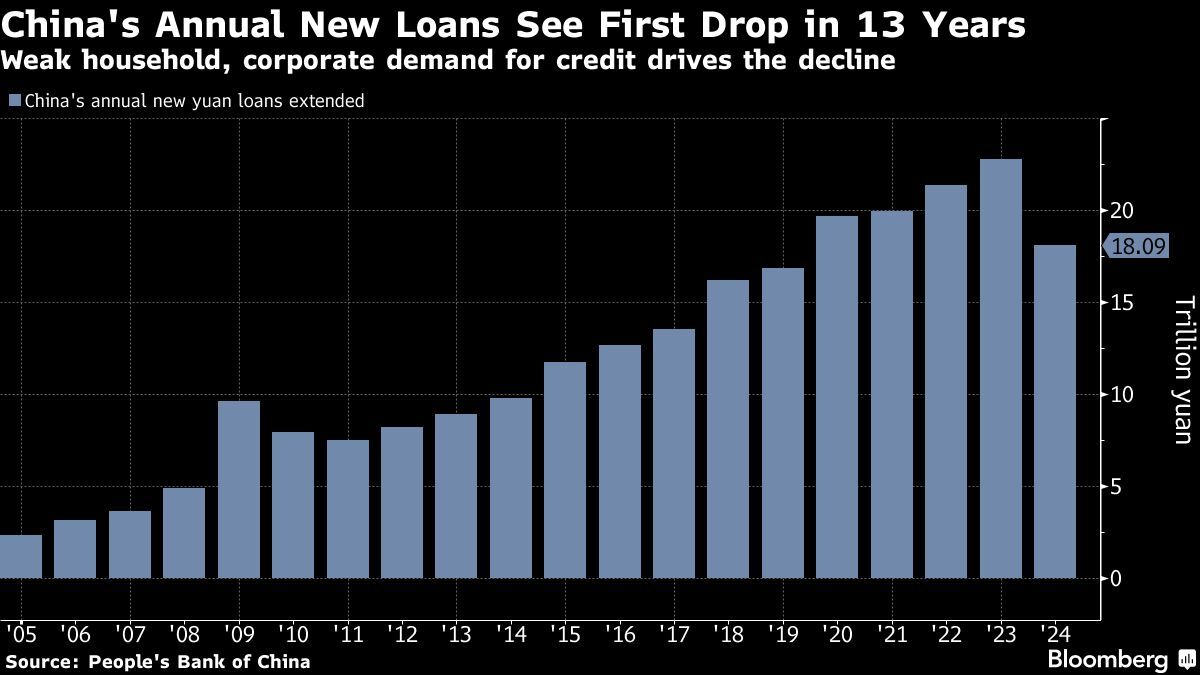
Financial institutions offered 18.09 trillion yuan of new loans in 2024, according to data released by the People’s Bank of China. (Photo by Bloomberg)
(Jan 14): New loans extended by Chinese banks posted their first decline since 2011 last year, underscoring weak demand for financing in the economy plagued by lingering deflation and a housing slump.
Financial institutions offered 18.09 trillion yuan (RM11.10 trillion) of new loans in 2024, according to data released by the People’s Bank of China on Tuesday. That compares with a median forecast of 17.87 trillion yuan by economists in a Bloomberg survey. It was lower than the previous year’s volume of 22.75 trillion yuan, representing the first annual drop in 13 years.
Aggregate financing, a broad measure of credit, rose 32.26 trillion yuan, less than the 35.59 trillion yuan recorded in 2023, PBOC figures showed. The median forecast was 31.56 trillion yuan.
Subdued borrowing demand from the household and corporate sectors drove the declines in credit numbers in 2024. While China’s economic momentum improved in recent months on the back of Beijing’s stimulus blitz, its growth prospects this year remain far from upbeat, hobbled by persistent deflation and with a trade war looming with the US.
Policymakers will need to roll out more assertive policies to help domestic demand recover and help absorb any blow to export growth from the expected US tariff hikes. The government has ramped up bond issuance to ease the debt risks of local governments, providing a boost to overall credit, and top leaders have promised to cut interest rates and unleash long-term interbank liquidity to encourage lending.
The PBOC is having to balance its competing goals of supporting growth and preventing the yuan from depreciating too fast. It’s so far held back from easing monetary policy with steps such as a cut to banks’ reserve requirement ratio, since that could put more pressure on the yuan and fuel capital outflows.
Policymakers are also likely keeping some stimulus in reserve should it be needed to contain trade shocks after Donald Trump’s inauguration as US president this month.
Uploaded by Arion Yeow
- Gamuda, IJM, MRCB, SunCon could bid for Penang International Airport's main terminal building under Package 3 in May, estimated at RM1.2b — CIMB
- AmBank grants RM307m in financing to Chin Hin Group for infrastructure projects
- Intel CEO invested in hundreds of Chinese companies, some with military ties
- Umno wants transfer of Seri Pacific hotel land held under trusteeship of Dr M, Daim, two others
- YNH Property's independent review reveals interconnected directors, shareholders in RM1.1b JV deals
- Selloff accelerates on Wall Street, traders weigh risks as tariffs on China reported to have gone up to 145%
- Anwar receives courtesy visit from tech giant Oracle, discusses AI and digital innovation
- EU, Belgium stress need for closer ties with Malaysia amid shifting global trade
- Yellen says bond sell-off raised instability threat, influencing Trump tariff U-turn
- Trump tariff pause leaves CEOs asking: What happens in 90 days?

